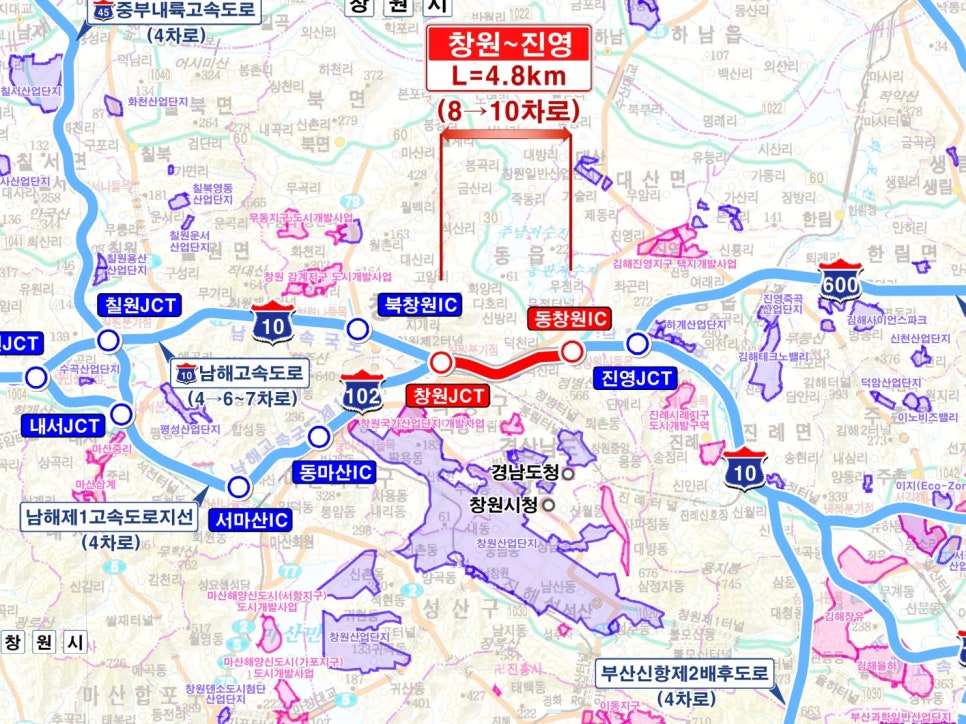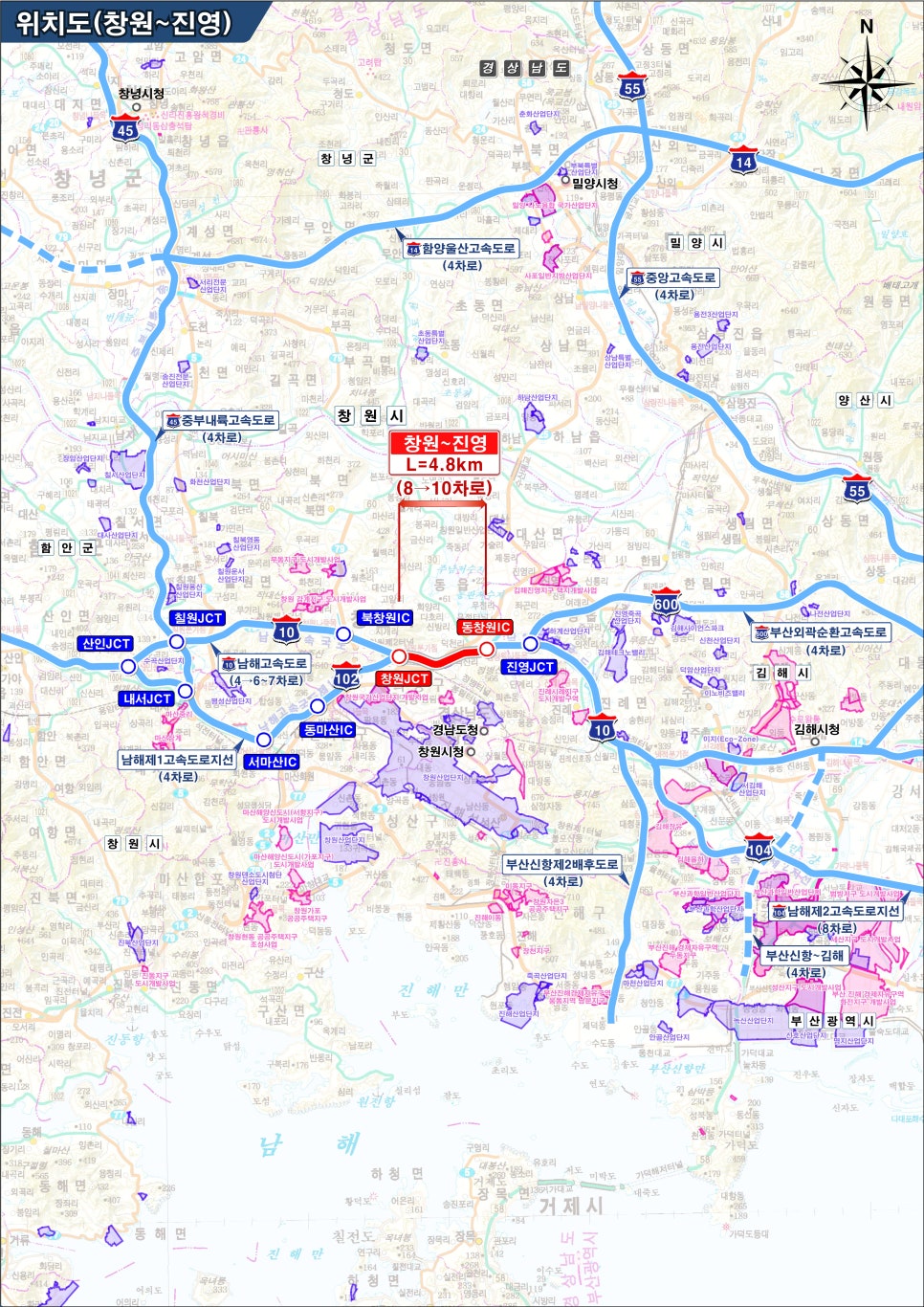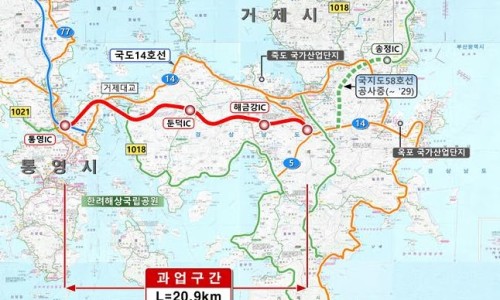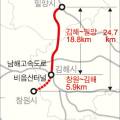Table of Contents
Selection of the Changwon-Jinyeong Expressway Expansion Project as a Preliminary Feasibility Study Target

Recent attention has been focused on the new tunnel construction project in the Gimhae Bieumsan area, but the chosen project is not that.
Instead, the expansion of the Changwon-Jinyeong section of the Namhae Expressway that connects Changwon and Jinyeong has been finally selected. This project focuses on addressing the traffic congestion issues in the ChangwonJCT and DongChangwonIC segments.
This section is a major logistics route connecting Gyeongnam Changwon and Gimhae, and it is also an important transportation network linking the Changwon Industrial Complex and the Busan-Gimhae area. This project is anticipated to significantly impact the local economy, seen as a crucial opportunity to reduce traffic congestion and improve logistics efficiency.
Helpful Posts to Check
Overview of the Changwon-Jinyeong Expressway Expansion Project

The section from ChangwonJCT in Changwon City, Gyeongnam to DongChangwonIC is 4.8 km long and is planned to be expanded from the current 8 lanes to 10 lanes. The total cost required for this project is approximately 121.8 billion won, based on the preliminary feasibility study.
The Changwon-Jinyeong Expressway is an important transportation network connecting the main line of the Namhae Line and the Namhae 1st Branch, and the Busan Outer Ring Road. However, due to lane imbalance and bottleneck phenomenon, congestion has frequently occurred, causing inconvenience to drivers.
This lane expansion project aims to solve such issues and harmonize the number of lanes with connected sections for smooth traffic flow.
Current Status of Traffic Congestion

Currently, the daily traffic volume on the Changwon-Jinyeong section exceeds 120,000 vehicles. As a result, it has recorded a grade D in expressway service level evaluations, and even a slight increase in traffic volume causes congestion.
In particular, at major junctions connecting Busan and Suncheon, bottlenecks occur as the number of lanes decreases from 10 to 8, 6, and 4 lanes. This situation leads to concentrated truck traffic and increased risk of traffic accidents, causing persistent congestion issues. Consequently, many drivers are experiencing inconvenience.
Necessity and Expected Effects of the Project

This project is part of the 2nd expressway construction plan (2021-2025), being actively pursued to solve problems in congested sections. With the completion of the preliminary feasibility study, it is now possible to proceed in earnest.
Once this project is completed, various positive effects are expected to manifest. Chronic congestion will be alleviated, the risk of traffic accidents will decrease, and the efficiency of logistics movement is also expected to increase. In particular, the improvement of logistics flow in large industrial complexes such as the Changwon National Industrial Complex and Masan Free Trade Zone is anticipated to invigorate the local economy.
Additionally, with the strengthening of integration with the regional traffic network connecting Busan, Gimhae, and Changwon, accessibility to logistics hubs in the southeast, such as Busan Port and Jinhae New Port, is projected to improve significantly. Such changes are expected to have a positive impact on local communities.
Conclusion
The expansion of the expressway connecting Changwon and Jinyeong is not simply about road expansion. This project carries significant meaning in solving bottleneck issues and strengthening the regional logistics network.
With the preliminary feasibility study now underway, a foundation for project promotion has been established. If subsequent procedures proceed swiftly, it will emerge as a key infrastructure contributing to improving the traffic environment in the Gyeongnam region and promoting economic growth.
#ChangwonJinyeongExpressway, #PreliminaryFeasibilityStudyTargetSelection, #ChangwonJCT, #DongChangwonIC, #NamhaeExpressway, #ExpresswayExpansion, #BottleneckResolution, #TrafficCongestionResolution, #ChangwonTraffic, #JinyeongTraffic, #GyeongnamTrafficNetwork, #BusanOuterRingRoad, #Namhae1stBranch, #ExpresswayServiceLevel, #LogisticsMovementEfficiency, #ChangwonIndustrialComplex, #MasanFreeTradeZone, #BusanPortConnection, #JinhaeNewPortAccessibility, #TrafficCongestionImprovement, #RegionalTrafficNetworkExpansion, #GyeongnamEconomy, #IndustrialLogisticsAxis, #ExpresswayProject, #2025FiscalProjectEvaluation, #LaneImbalanceResolution, #RoadInfrastructureExpansion, #TrafficSafetyImprovement, #CommuteCongestionResolution, #GyeongnamNews
Frequently Asked Questions (FAQ)
Q. What section does the Changwon-Jinyeong Expressway Expansion Project target?
Expanding the section from ChangwonJCT to DongChangwonIC, covering 4.8 km.
This expansion project targets a total of 4.8 km from ChangwonJCT in Changwon City, Gyeongnam to DongChangwonIC. The main goal is to address traffic congestion and bottlenecks by expanding from 8 lanes to 10 lanes. This section is a core part of the Namhae Expressway, serving as an important logistics route connecting the Changwon Industrial Complex and the Busan-Gimhae area.
Q. What is the main purpose of this expressway expansion project?
The main purposes are alleviating traffic congestion and improving logistics movement efficiency.
The expansion project focuses on resolving lane imbalance and bottleneck problems in the ChangwonJCT to DongChangwonIC section, aiming to improve persistent congestion issues. With daily traffic exceeding 120,000 vehicles, the service level remains at grade D; thus, lane expansion is planned to ensure smooth traffic flow and durability. Additionally, the improvement in logistics movement efficiency is expected to stimulate the local economy.
Q. What is the current status of traffic congestion?
Bottlenecks are significant, with daily traffic exceeding 120,000 vehicles.
In the Changwon-Jinyeong section, over 120,000 vehicles pass daily, and bottlenecks frequently occur at major nodes connecting Busan and Suncheon, where the number of lanes reduces from 10 to 8, 6, and 4. This has led to intensified truck traffic and increased risk of traffic accidents, causing inconvenience and safety issues for drivers.
Q. What are the expected benefits upon completion of the expansion project?
Reduction in traffic congestion and accident risk, along with enhanced logistics efficiency, are expected.
Once completed, chronic traffic congestion is anticipated to be alleviated and the risk of traffic accidents will decrease. Logistics movement efficiency will also increase, contributing to improved logistics flow from key industrial zones like the Changwon National Industrial Complex and Masan Free Trade Zone. Accessibility to logistics hubs in the Southeast, such as Busan Port and Jinhae New Port, is expected to significantly enhance, positively impacting local economic development.
Q. What plan is this project part of, and what is the current progress?
It is part of the 2nd expressway construction plan for 2022, and the preliminary feasibility study has been completed.
The Changwon-Jinyeong Expressway expansion project is a significant project within the 2nd expressway construction plan, implemented from 2021 to 2025. Having recently been selected for the preliminary feasibility study, it has reached a stage where earnest promotion is possible, and rapid progress in subsequent procedures is expected to aid in early completion and improvement of the regional traffic environment.


